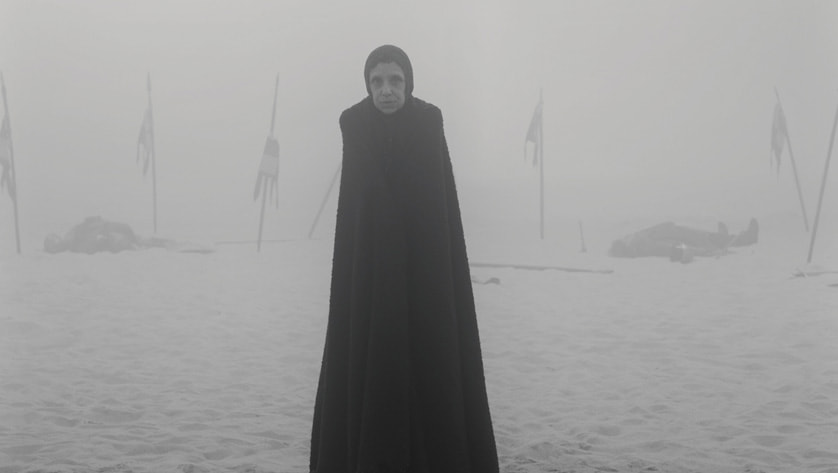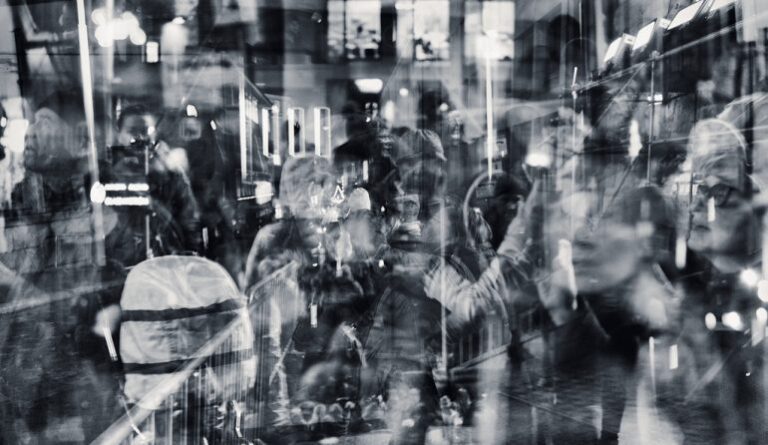A Trick of the Light

In Joel Coen’s recent film adaptation of Shakespeare’s Macbeth, Macbeth stands in the dimly lit hall of his home and contemplates his destiny. Fresh off an encounter with a set of witches, the weird sisters, who promise that he will become thane of Cawdor and then king of Scotland, Macbeth contemplates King Duncan’s murder. He gazes at the door that separates him from Duncan and stares at a flash of bright metal: “Is this a dagger which I see before me,” he asks. Torn between the contradictory input of his senses—“Come, let me clutch thee. / I have thee not, and yet I see thee still”—Macbeth struggles to interpret his experience. Is this a true, sensible vision or “a false creation,” the product of a “heat-oppressed brain”?
The film’s visual play makes both true. The scene, viewed initially from Macbeth’s perspective, shows a shining, ghostly dagger floating in midair just out of reach. As Macbeth advances down the hall, however, the light shifts and the perspective changes: the dagger transforms into a door handle. The brilliance of Coen’s scene lies in its framing as a hermeneutic challenge. Like the proverbial duckrabbit, the answer to Macbeth’s question—Is this a dagger?—depends on how it’s seen.
Macbeth, played by Denzel Washington who favors a wondering, contemplative judgment over dizzying madness in this scene, comes to conclude that there is no dagger. “It is the bloody business which informs / Thus to mine eyes,” but the matter proves not to be so simple. For, as he immediately begins to detail, the world around him is filled with nightmares, disordered visions, and witchcraft. Perhaps the shifting perspective on the dagger is just a trick of the light aided by his own murderous thoughts and desire. It might also be a wicked dream, a portent stirred to life as “witchcraft celebrates / Pale Hecate’s offerings.” Coen’s visual focus on perspective and Washington’s contemplative Macbeth suggest that both might be true. This “fatal vision” might be dagger or handle, a product of his own mind or of witchcraft.
Macbeth’s interpretative trouble would have been familiar to Shakespeare’s Early Modern audience as a problem inherent in witchcraft itself. First performed in 1606 and written during the first years of King James I’s reign, Macbeth is steeped in a cultural fascination with, and growing fear over, witches. Popular broadsides like Newes from Scotland (1591) published tales of witches making deals with the devil and plotting the king’s assassination. Works like the Malleus Maleficarum (the Hammer of Witches) from 1486 offered guides to the practices and motivations of witches as well as the means of torturing and prosecuting them. James I (while still King James VI of Scotland before his succession to the English throne) had himself only a decade prior written the Daemonologie (1597), a philosophical dialogue covering a range of topics from the prosecution of witches to the practice of divination. A central thematic concern of texts like these was the relationship between witchcraft and perception. Could witches shape reality, or, at least, how we see it?
According to the Malleus Maleficarum, the answer is complicated. Drawing on medieval European and Arabic theories of memory and perception, it argues that, while there are limits to what witches can materially change, working in pact with demons, they can “stir up and excite the inner perceptions and humours, so that ideas retained in the repositories of [men’s] minds are drawn out and made apparent to the faculties of fancy and imagination, so that such men imagine these things to be true.” Witches can manipulate people by drawing on their memories, sense perceptions, and feelings to shape and alter their understanding of the world—such as manifesting a dagger before the eyes of a man tempted to murder. Further complicating things, such perceptions might also be divine visions (it was thought that God could work through witches to reveal truths), or even a form of illness. Unpacking the forces behind perception required careful acts of interpretation in order to understand what they meant and who had sent them.
Of particular challenge were cases that dealt with foreknowledge and revelation of fate or destiny—the particular purview of Macbeth’s witches, the weird sisters. Weird, an archaic term primarily confined to Scotland in the 17th century, derives from the Old English wyrd, meaning fate or destiny, and the verb weorþan, to become. Macbeth’s weird sisters tell what is to come, what someone will become. The hermeneutic problem of witchcraft is amplified in considering the future: signs and their meaning, the sources of future knowledge themselves, made murkier by the expanded distance between immediate, concrete reality and a projected future time. Perhaps most dangerously, however, as James I in his Daemonologie had warned, demons and witches can speak partial truths about the future. These truths are gleaned through a studied observation of the nature of the world and human nature or perhaps even through the will of God. People who “wilfully decei[ve] themselves” are particularly susceptible to these partial truths and are foolishly unable to see that, even when true, they conceal and hide. Such willful self-deceit is an avenue to madness, leading to a denial of reality as interpretative capacities shut down, privileging partial truths and ignoring unfavorable realities.
This is Macbeth’s tragic failure: to be so hypnotized by what he would become that he fails to interpret correctly the doubling, shifting nature of what the witches reveal. This is different from saying that Macbeth simply does not interpret correctly (that he sees a dagger when he should see a door handle). What I mean here is that Macbeth’s failures are failures to understand the interplay of perspective and perception in interpretation. He becomes so consumed with his wyrd that he must kill Duncan (and the guards, and Banquo, and Macduff’s family); he cannot or will not see alternatives. The witches conjure a series of riddling apparitions that seem to promise safety and prosperity—Macbeth will never be defeated until “Great Birnam wood to high Dunsinane hill / Shall come against him”; “none of woman born / Shall harm Macbeth”—but he sees only the literal. He never considers that these words might have another meaning (an army in camouflage, a man born via caesarian section). These failures have ethical and psychological weight. They push him to pile murder on murder and to face with irrational confidence the armies coming to overthrow him.
The success of Coen’s adaptation lies in his ability to make the challenge (and failure) to understand perception visible. The dagger/doorhandle scene is one of the most striking examples, but others include an abrupt shift in camera angle that transforms a ghost into a raven, and a series of brief shots through large, arched windows that change an army camouflaged with branches into an actual forest. In the background, but deeply embedded into each scene through echoing sounds—a repeated rhythmic drip of water, a shudder of wings—and sharp visuals—an old man with a witch’s face, flocks of birds—are the witches, brilliantly performed by Kathryn Hunter. From their first appearance, the witches challenge perception. What appears to be one witch, standing alone, contorting her body as she prophesies, is revealed to be three as the camera angle shifts to show the witch standing over a pool, her black silhouette transformed into a trio. Whether there is one witch or three turns out to be a matter of perception. Coen embeds the witches into the film’s landscape so that we cannot forget their presence and their interpretative powers, and we are made to see the interpretative challenge Macbeth faces. This is a world in which witchcraft celebrates Hecate, in which language and perception riddles and doubles on itself. Coen’s Macbeth’s madness and failure is to fail to understand the nature of the world he lives in.


